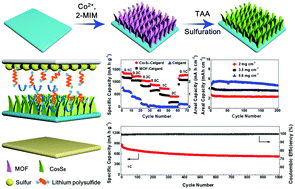当前位置:
X-MOL 学术
›
Energy Environ. Sci.
›
论文详情
Our official English website, www.x-mol.net, welcomes your
feedback! (Note: you will need to create a separate account there.)
Vertical Co9S8 hollow nanowall arrays grown on a Celgard separator as a multifunctional polysulfide barrier for high-performance Li–S batteries†
Energy & Environmental Science ( IF 32.4 ) Pub Date : 2018-06-19 00:00:00 , DOI: 10.1039/c8ee00893k Jiarui He 1, 2, 3, 4, 5 , Yuanfu Chen 5, 6, 7, 8 , Arumugam Manthiram 1, 2, 3, 4
Energy & Environmental Science ( IF 32.4 ) Pub Date : 2018-06-19 00:00:00 , DOI: 10.1039/c8ee00893k Jiarui He 1, 2, 3, 4, 5 , Yuanfu Chen 5, 6, 7, 8 , Arumugam Manthiram 1, 2, 3, 4
Affiliation

|
Lithium–sulfur (Li–S) batteries have been regarded as one of the most promising next-generation energy-storage devices, due to their low cost and high theoretical energy density (2600 W h kg−1). However, the severe dissolution of lithium polysulfides (LiPSs) and the fatal shuttle effect of the sulfur cathode seriously hinder the practical applications of Li–S batteries. To address such issues, we present here, for the first time, a novel metal organic framework (MOF)-derived Co9S8 nanowall array with vertical hollow nanoarchitecture and high electrical conductivity, which is grown in situ on a Celgard separator (Co9S8–Celgard) via a feasible and scalable liquid-reaction approach, as an efficient barrier for LiPSs in Li–S batteries. Benefiting from the direct in situ growth of vertical Co9S8 hollow nanowall arrays as a multifunctional polar barrier, the Co9S8–Celgard separator possesses large surface area, excellent mechanical stability, and particularly strong LiPS-trapping ability via chemical and physical interactions. With these advantages, even with a pure sulfur cathode with a high sulfur loading of 5.6 mg cm−2, the Li–S cells with the Co9S8–Celgard separator exhibit outstanding electrochemical performance: the initial specific capacity is as high as 1385 mA h g−1 with a retention of 1190 mA h g−1 after 200 cycles. The cells deliver a high capacity of 530 mA h g−1 at a 1C rate (1675 mA g−1) even after an impressive number of 1000 cycles with an average capacity fade of only 0.039% per cycle, which is promising for long-term cycling application at high charge/discharge current densities, and pouch-type Li–S cells with the Co9S8–Celgard separator display excellent cycling performance. When the optimized cathode with the sulfur loading in well-designed yolk–shelled carbon@Fe3O4 (YSC@Fe3O4) nanoboxes is employed, the cell with Co9S8–Celgard delivers a high initial capacity of 986 mA h g−1 at a 1C rate with a capacity retention as high as 83.2% even after a remarkable number of 1500 cycles. This work presents a strategy to grow on the separator a multifunctional polar interlayer with unique nanoarchitecture and high conductivity to chemically and physically trap the LiPSs, thus significantly enhancing the performance of Li–S batteries.
中文翻译:

在Celgard隔板上生长的 垂直Co 9 S 8中空纳米壁阵列,作为多功能Li-S电池的多功能多硫化物阻挡层†
锂硫(Li–S)电池由于其低成本和高理论能量密度(2600 W h kg -1)而被视为最有前途的下一代储能设备之一。但是,多硫化锂(LiPSs)的严重溶解和硫阴极的致命穿梭效应严重阻碍了Li-S电池的实际应用。为了解决这些问题,我们在这里提出,对于第一时间,一种新型的金属有机骨架(MOF)衍生的共9小号8纳米墙排列与竖直中空纳米架构和高导电性,这是生长在原位上的Celgard隔板(联合9 S 8 –Celgard)通过一种可行且可扩展的液体反应方法,作为Li-S电池中LiPS的有效屏障。受益于垂直的Co 9 S 8中空纳米壁阵列的直接原位生长作为多功能极性屏障,Co 9 S 8 -Celgard隔膜具有较大的表面积,出色的机械稳定性以及通过化学和物理方法特别强的LiPS捕集能力互动。凭借这些优势,即使使用高硫负载量为5.6 mg cm -2的纯硫阴极,带有Co 9 S 8的Li–S电池–Celgard隔膜具有出色的电化学性能:200次循环后,初始比容量高达1385 mA hg -1,保留率达1190 mA hg -1。即使经过令人印象深刻的1000次循环,每个循环的平均容量衰减仅为0.039%,这些电池仍以1C的速率(1675 mA g -1)提供530 mA hg -1的高容量,这对于长期使用来说是有希望的在高充电/放电电流密度下进行循环应用,带有Co 9 S 8 –Celgard隔膜的袋型Li–S电池表现出出色的循环性能。当设计良好的蛋黄壳碳@Fe 3 O 4中的硫负载优化阴极时使用(YSC @ Fe 3 O 4)纳米盒,带有Co 9 S 8 -Celgard的电池以1C的速率提供了986 mA hg -1的高初始容量,即使经过相当数量的放电,其容量保持率仍高达83.2% 1500个周期。这项工作提出了一种在隔膜上生长具有独特纳米结构和高电导率的多功能极性夹层的策略,以化学和物理方式捕获LiPS,从而显着提高了Li-S电池的性能。
更新日期:2018-06-19
中文翻译:

在Celgard隔板上生长的 垂直Co 9 S 8中空纳米壁阵列,作为多功能Li-S电池的多功能多硫化物阻挡层†
锂硫(Li–S)电池由于其低成本和高理论能量密度(2600 W h kg -1)而被视为最有前途的下一代储能设备之一。但是,多硫化锂(LiPSs)的严重溶解和硫阴极的致命穿梭效应严重阻碍了Li-S电池的实际应用。为了解决这些问题,我们在这里提出,对于第一时间,一种新型的金属有机骨架(MOF)衍生的共9小号8纳米墙排列与竖直中空纳米架构和高导电性,这是生长在原位上的Celgard隔板(联合9 S 8 –Celgard)通过一种可行且可扩展的液体反应方法,作为Li-S电池中LiPS的有效屏障。受益于垂直的Co 9 S 8中空纳米壁阵列的直接原位生长作为多功能极性屏障,Co 9 S 8 -Celgard隔膜具有较大的表面积,出色的机械稳定性以及通过化学和物理方法特别强的LiPS捕集能力互动。凭借这些优势,即使使用高硫负载量为5.6 mg cm -2的纯硫阴极,带有Co 9 S 8的Li–S电池–Celgard隔膜具有出色的电化学性能:200次循环后,初始比容量高达1385 mA hg -1,保留率达1190 mA hg -1。即使经过令人印象深刻的1000次循环,每个循环的平均容量衰减仅为0.039%,这些电池仍以1C的速率(1675 mA g -1)提供530 mA hg -1的高容量,这对于长期使用来说是有希望的在高充电/放电电流密度下进行循环应用,带有Co 9 S 8 –Celgard隔膜的袋型Li–S电池表现出出色的循环性能。当设计良好的蛋黄壳碳@Fe 3 O 4中的硫负载优化阴极时使用(YSC @ Fe 3 O 4)纳米盒,带有Co 9 S 8 -Celgard的电池以1C的速率提供了986 mA hg -1的高初始容量,即使经过相当数量的放电,其容量保持率仍高达83.2% 1500个周期。这项工作提出了一种在隔膜上生长具有独特纳米结构和高电导率的多功能极性夹层的策略,以化学和物理方式捕获LiPS,从而显着提高了Li-S电池的性能。











































 京公网安备 11010802027423号
京公网安备 11010802027423号